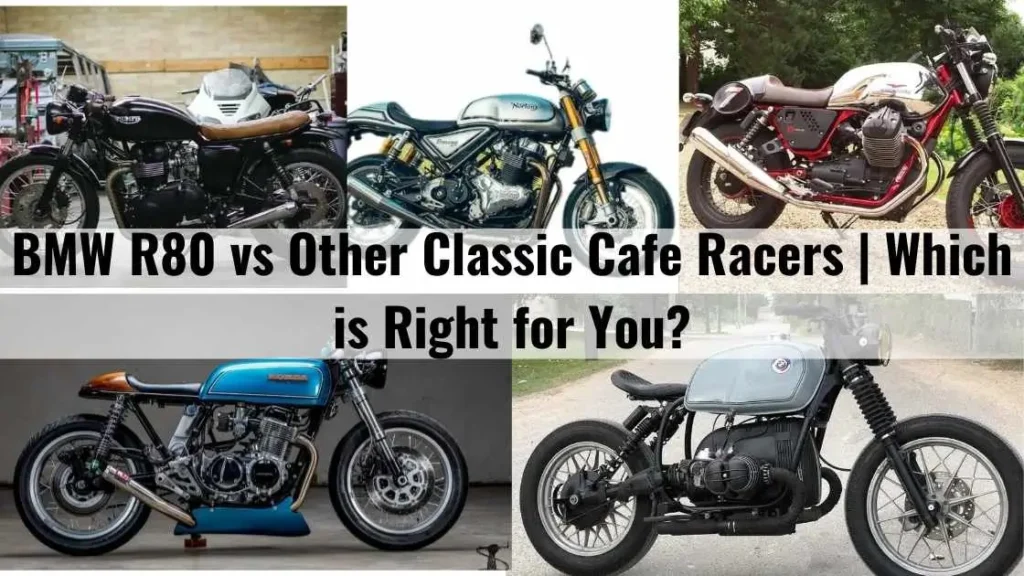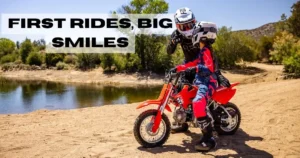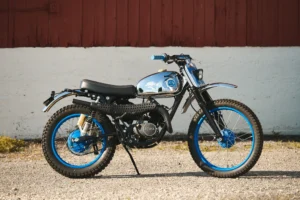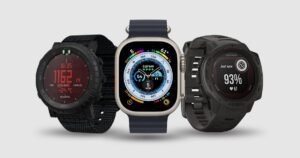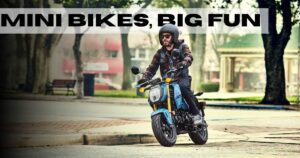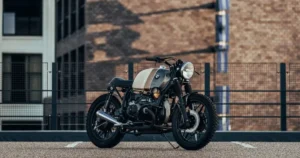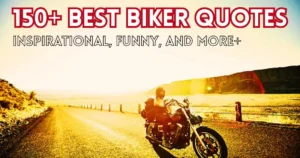Table of Contents
ToggleYou know, there’s something special about cafe racers. Every time I see one of these cool old motorcycles zoom by, it feels like seeing the past and future in one fast, loud machine. If you like bikes, you’ve probably heard people say ‘cafe racer’ a lot. But what does that mean, and why do so many people love these bikes? Well, grab a cup of coffee (just a fun joke!), because we’re talking about classic cafe racers today—especially the famous BMW R80 and how it compares to other well-liked models.
What Are Cafe Racers?
Let’s start at the beginning. Cafe racers are light, fast motorcycles that started in the 1960s. They were all about going fast, looking cool, and getting from one café to another really quickly (that’s why they’re called cafe racers). Back then, riders would take off extra parts to make their bikes lighter and faster, and that simple, clean look is what makes cafe racers special today. You’ve probably seen their low shape, clip-on handlebars, and their simple, clean style.
Why The BMW R80?
So why are we talking about the BMW R80? Well, it’s one of the most famous cafe racers, known for its classic engine and how easy it is to change and make special. Whether you’re new to cafe racers or have been around bikes for a long time, the BMW R80 always stands out. It’s got the perfect mix of history, power, and style, which is why a lot of people like to turn it into a bike that fits their own taste.
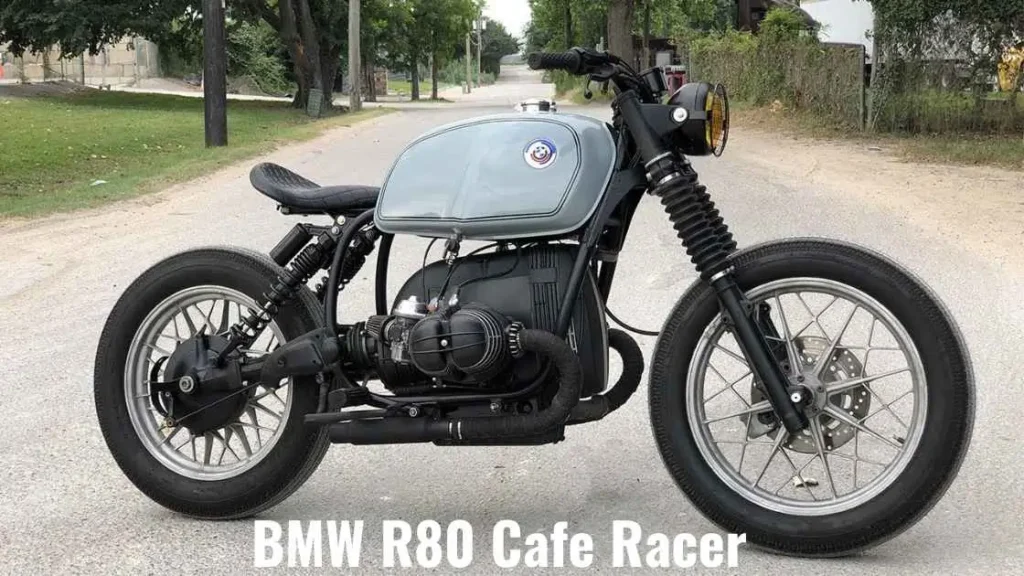
But the BMW R80 isn’t the only bike out there. There are lots of other classic cafe racers—like the Triumph Bonneville, Honda CB750, Norton Commando, and even Moto Guzzi V7. Each of these bikes is special in its own way, but which one is right for you? Let’s find out by comparing these famous bikes and looking at their history, performance, and how much you can change them to make them your own.
Why is the BMW R80 a Great Bike?

Let’s talk about the star of the show—the BMW R80. Now, this bike isn’t just a piece of metal; it’s something special. If you love motorcycles, you know that some bikes have a bit of magic to them, and the R80 is just like that. It first came out in the late 1970s, and it has become a favorite for people who love cafe racers. Why? Well, it has an engine that mixes old-style coolness with modern reliability. That air-cooled boxer engine doesn’t just look cool; it’s also known for being strong and giving a unique riding experience.
Design and Aesthetic
The BMW R80 is famous for its special boxer engine, which makes the bike look wide because of the cylinders sticking out to the sides. This engine not only looks cool, but it also helps the bike stay balanced. Plus, the engine’s low position makes it easier to handle—something important if you want to turn this bike into a quick cafe racer.
One thing that makes the BMW R80 special is how easy it is to change how it looks. Whether you want a clean, simple style or a tougher, racer look, the bike’s frame and design make it easy to change. People often take off the airbox, change the back part, and swap the exhaust to give it that slim, cafe racer style.
Performance Specs
But let’s talk about the numbers. What’s inside this bike? The BMW R80 has a 797cc air-cooled, four-stroke engine that gives about 50 horsepower and 41 lb-ft of torque. That might not seem like a lot today, but remember, we’re talking about classic bikes. For a cafe racer, the R80 has more than enough power to make you happy when you twist the throttle and zoom through the streets.
When it comes to performance, it’s known for being smooth and steady. The shaft drive makes it even more reliable (no chains to worry about), and the handling is well-balanced because of that wide engine. People who like to customize their bikes often change the suspension to make it a bit quicker, but even without changes, the R80 is a great performer.
Customization Potential
Now, if you’re like me, the fun part of a bike is how much you can change it. The BMW R80 is perfect for people who love to build and change things. You can do almost anything, like change the subframe, add a custom exhaust, or strip the bike down to its basics to get that cool cafe racer look. You can lower the handlebars, swap out the back shocks, and make the bike look simple and raw.
Some people add clip-on handlebars, small seats, and special body parts to make the R80 look unique. A popular change is to switch the seat for a wasp-tail cowl and move the foot pegs back, so you get that leaned-forward riding position that cafe racers are known for. Many people also like to upgrade the suspension to make the ride tighter and more fun. In the cafe racer world, the BMW R80 is like a blank canvas—just waiting for you to make it your own.
Pros and Cons of the BMW R80 as a Cafe Racer
Every bike has things it’s good at and things that might not be as good, and the BMW R80 is the same. Let’s look at it
Pros:
- Reliability: The air-cooled boxer engine is very strong and built to last, even though it’s an old design.
- Customization Options: You can change almost anything, from the frame to the engine and more.
- Classic Appeal: If you love a vintage, tough look, the R80 is perfect—like riding a piece of history.
- Handling: Its low center of gravity makes it stable, especially with suspension upgrades.
Cons:
- Weight: The R80 can feel a bit heavy compared to other cafe racers, especially in its stock form. Modifying it can help make it lighter.
- Power: While it’s not slow, it doesn’t have the raw speed of modern bikes. You might need to tune the engine or add performance upgrades if you want more power.
Other Classic Bikes You Might Like
Now that we’ve had a good look at the BMW R80, it’s time to look at its rivals. The cafe racer world is full of famous bikes, and each one has its own cool style, history, and power. I’ll tell you about some of the most popular classic cafe racers, like the Triumph Bonneville, Honda CB750, Norton Commando, and Moto Guzzi V7. Whether you like British bikes or want Japanese bikes that are super reliable, there’s something for every cafe racer fan here.
Triumph Bonneville
First, let’s talk about the Triumph Bonneville. If the BMW R80 is like a strong, dependable worker, the Bonneville is the shiny, retro star. It first came out in the 1950s, and it’s one of the most famous British motorcycles ever. Its classic look, along with its smooth performance, has made it super popular in the cafe racer world.
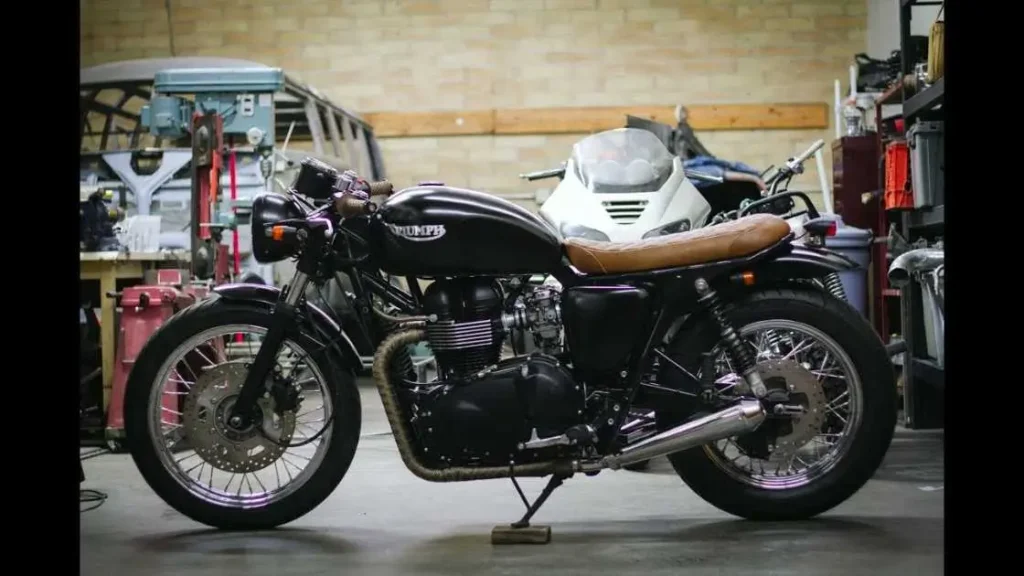
Design and Aesthetic
The Bonneville has a classic British parallel twin engine, and its frame looks more traditional compared to the wider BMW R80. With shiny chrome, spoked wheels, and a low seat, the Bonneville is full of ‘retro charm.’ But even though it looks vintage, it still performs well. It’s also one of the easiest bikes to customize, which is why riders love to make it their own.
Performance
The modern Triumph Bonneville has an air-cooled 865cc engine that gives about 68 horsepower. It’s got a bit more power than the BMW R80, but it’s known for being smooth and easy to ride, not just for speed. It’s great for all-around riding and gives a more relaxed ride than some of the faster bikes out there.
Customization Potential
Like the R80, the Bonneville is a favorite for people who love to customize bikes. You can change a lot of things, like adding clip-on handlebars or a custom exhaust. Builders also change the suspension to make it handle better or add retro-style seats to make it look even more vintage. There are lots of parts you can buy, which makes customizing a Bonneville fun and affordable.”
Honda CB750
Next up is the Honda CB750, another big name in the cafe racer world. This bike changed motorcycling when it came out in 1969, and it’s even in the Motorcycle Hall of Fame. It’s often called one of the first ‘superbikes’ because of its powerful engine and smart design.
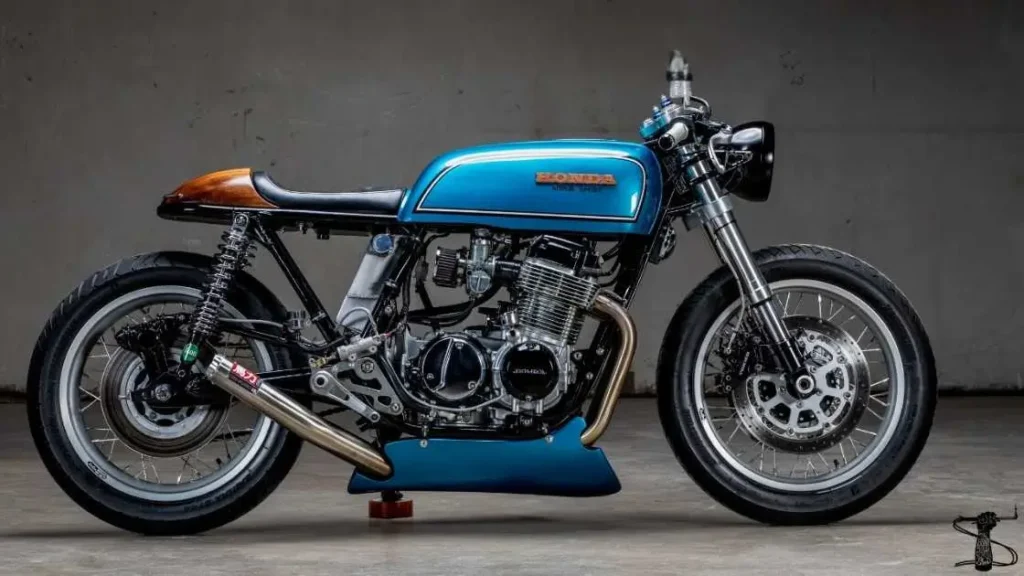
Design and Aesthetic
The Honda CB750 looks a bit stronger compared to other cafe racers. Its inline-four engine gives it a bigger look, but that also means it has great power. Visually, the CB750 is somewhere between the slim look of the Triumph Bonneville and the bulkier BMW R80, making it a good choice if you want a mix of style and strength.
Performance
The CB750 has a 736cc inline-four engine, which was amazing when it first came out. It gives about 67 horsepower, similar to the Triumph Bonneville. But what makes the CB750 special is how smooth and reliable the engine is. Honda always focuses on making bikes that are not just powerful but also dependable, and the CB750 is a great example of that.
Customization Potential
Just like the BMW R80 and Bonneville, the CB750 is very popular for customizing. Riders love turning these bikes into cafe racers by making them lighter, lowering the stance, and changing parts like the seat and handlebars. One big reason people love the CB750 is its easy-to-work-on design, so it’s simple to change and make your own. Whether you want to build a retro-style cafe racer or something more modern, the CB750 gives you lots of options to try.
Norton Commando
The Norton Commando is another classic British bike that has a special place in cafe racer history. Known for its smooth handling and vintage look, the Commando has fans who love its more traditional cafe racer feel.
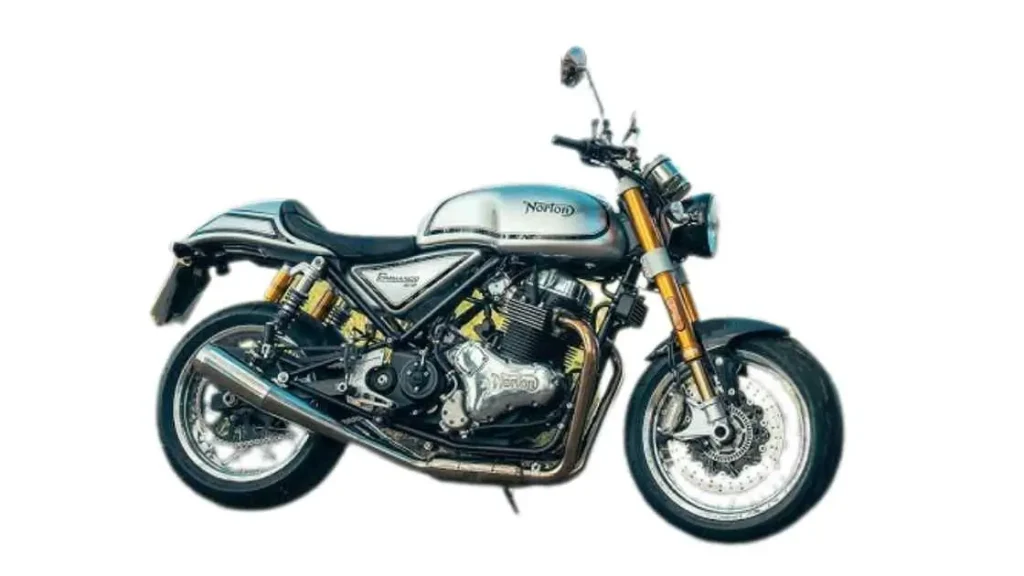
Design and Aesthetic
With its slim frame and special featherbed frame, the Norton Commando has a more classic look compared to the bigger BMW R80. It’s built to be fast and easy to handle, making it a favorite for riders who like the racetrack feel. The Commando is loved for its simple look and tight handling, which is just what you want in a cafe racer.
Performance
The Commando has a 745cc parallel-twin engine with around 58 horsepower. It’s not the fastest bike, but it’s great handling makes up for that. Thanks to its smart Isolastic suspension system, the Commando gives a smoother ride than many other bikes, even at higher speeds. It’s a great choice if you want a bike that feels more ‘classic’ but still performs well.
Customization Potential
Like the other bikes on this list, the Norton Commando is fun to customize. You can change things like the seat or add retro paint to make it your own. But because it’s a more old-fashioned bike, people often stick to simple changes that keep its classic look instead of making it look more modern and aggressive.
Moto Guzzi V7
Last but not least, we have the Moto Guzzi V7. This classic Italian bike might not be as famous as some of the others on this list, but it’s definitely a strong choice in the cafe racer world. The V7 has its own special charm with its retro style and air-cooled transverse V-twin engine, making it different from its British and Japanese rivals.
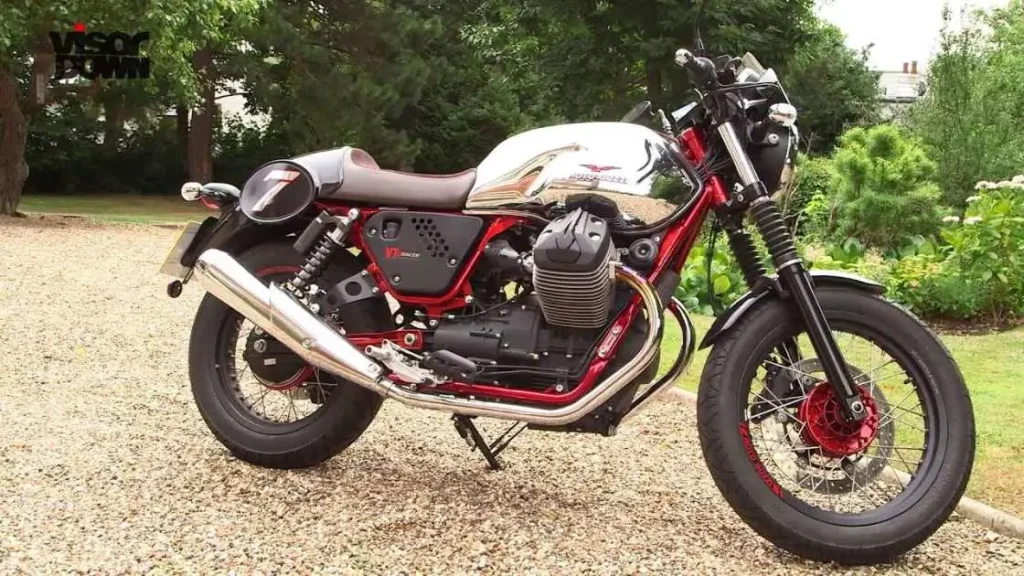
Design and Aesthetic
The Moto Guzzi V7 has a unique, almost fun look. Its transverse V-twin engine sticks out on both sides, like the boxer engine on the BMW R80, but it feels more compact. This bike is great for riders who want something a little different in both design and performance. Its simple look makes it easy to customize into a cafe racer, and it has that cool Italian style.
Performance
The V7 isn’t the most powerful bike here, with its 744 cc engine making around 52 horsepower. But even though it doesn’t have a lot of power, it has a lot of character. The transverse V-twin gives it plenty of low-end torque, which makes it fun to ride, especially on twisty roads. It’s not made for speed, but if you want a bike with soul, the V7 is a great pick.
Customization Potential
The V7 is popular with custom builders, though not as common as the CB750 or Bonneville. Its special engine and small frame make it a great choice for turning into a cafe racer. People often add clip-on handlebars, custom exhausts, and retro-style seats to give it that cafe racer vibe. Since the V7 is a bit different, you’ll also see some more daring customizations, like bold body kits and cool paint jobs.
BMW R80 vs Other Cafe Racers
Now that we’ve looked at the BMW R80 and its competitors, it’s time to get into the details. Let’s compare these cafe racers side by side in terms of engine performance, handling, how easy they are to customize, and how they feel to ride. Whether you want speed, comfort, or the chance to make the bike your own, this part will help you decide.
Engine and Performance Comparison
When you’re looking at cafe racers, the engine is one of the first things to think about. Cafe racers are all about speed and being quick, and while these bikes aren’t made for the racetrack, their engines each bring something special.
BMW R80:
The R80’s 797cc air-cooled boxer engine is famous for its design and smooth power. It makes 50 horsepower, and its low-end torque and shaft drive make it great for everyday riding. The engine’s low center of gravity helps with balance and handling, especially at slower speeds, so it’s fun to ride on city streets or winding roads. But if you want raw speed, the R80 might feel a little underpowered compared to the others.
Triumph Bonneville:
The Bonneville’s 865cc parallel twin engine has a bit more power, with 68 horsepower. It’s not super fast, but it’s known for being smooth and easy to ride. The Bonneville feels refined and comfortable, making it great for city riding and longer trips. If you want a bit more power but still want a comfy ride, the Bonneville is a bit better than the R80.
Honda CB750:
The Honda CB750 is a legend when it comes to power. Its 736cc inline-four engine gives 67 horsepower, making it strong on the road. The CB750’s engine is super smooth and revs higher and faster than boxer engines, giving it a sportier feel. If you want a cafe racer with more kick and like to push your bike harder, the CB750 might be the best choice, especially for highways or open roads.
Norton Commando:
The Norton Commando has a 745cc parallel twin engine with 58 horsepower, which puts it between the R80 and the Bonneville in terms of power. Its best feature is its Isolastic suspension, which smooths out vibrations and makes the bike feel nicer at high speeds. While not the fastest bike, the Commando is known for its handling and comfort, making it a good choice if you want a classic feel without losing too much performance.
Moto Guzzi V7:
The Moto Guzzi V7 has a transverse V-twin engine with 52 horsepower. It’s not the most powerful, but the engine’s unique design gives it plenty of low-end torque, which makes it fun to ride on twisty roads. The V7 isn’t built for speed, but if you’re looking for charm and character, the V7’s engine gives a special riding experience, especially if you enjoy relaxed weekend rides.
Handling and Riding Experience
Now, let’s talk about how these bikes feel when you ride them. Cafe racers are made to be light and quick, but each bike gives you a different experience with how they handle and how smooth they feel on the road.
BMW R80:
The R80’s low center of gravity and boxer engine make it handle smoothly, especially when turning. But the bike is a little heavy (about 450 lbs), which can make it feel a bit bulky in its regular form. Many people who customize the R80 choose to upgrade the suspension to make the handling tighter. If you want a balanced ride that’s comfortable and stable, the R80 is a good choice. It’s not the quickest bike, but it’s reliable and easy to predict.
Triumph Bonneville:
The Bonneville is known for its smooth ride. With its good suspension and lower seat, it’s very comfortable. It doesn’t feel as heavy as the R80 and handles turns with more agility. If you like comfort more than super-fast performance, the Bonneville is a great choice. It’s perfect for long rides or riding around the city, where how it feels to ride is more important than just speed.
Honda CB750:
The Honda CB750 feels more like a sportbike than a classic cafe racer. Its inline-four engine gives it a sportier and quicker feel, especially at higher speeds. The light frame makes it easy to turn corners, and the ride quality is great for an older bike. If you like fast riding and want a bike that can handle sharp turns and high speeds, the CB750 is a fantastic choice.
Norton Commando:
The Commando’s special feature is its Isolastic suspension, which absorbs vibrations better than most old bikes. This makes the ride smoother and more comfortable, even when you go fast. Its light frame and sharp handling make it feel quick, especially on twisty roads. It doesn’t have the power of the CB750, but the Commando offers a more classic and refined cafe racer experience.
Moto Guzzi V7:
The V7’s handling is a bit more relaxed. Its transverse V-twin engine gives it lots of low-end torque, making it fun to ride on winding roads. But the V7 isn’t as quick and nimble as some of the other bikes. It’s more of a cruiser than a fast bike, but if you want a bike with personality and a comfortable, laid-back ride, the V7 is a great choice.
Customization Potential
Cafe racers are all about making the bike your own, and each of these bikes offers different ways to customize them.
BMW R80:
The R80 is one of the most customizable bikes out there. Whether you want to change the subframe, add clip-on handlebars, or replace the exhaust, the R80 can be turned into almost any style you want. Its wide frame and boxer engine give it a special look that custom builders love to work with. If you like playing around with your bike, the R80 is a great choice.
Triumph Bonneville:
The Bonneville is also very easy to customize. Builders love its clean, simple lines and traditional frame, making it easy to add new seats, bars, and exhausts. There are lots of parts you can buy, so you won’t have any trouble finding what you need for your project.
Honda CB750:
The CB750 is famous for being versatile in the custom world. Whether you want to create a retro cafe racer or a more modern style, the CB750 has lots of options. You’ll often see custom rear sets, clip-ons, and even full subframe changes on these bikes. The CB750’s reliability makes it great for long-term projects.
Norton Commando:
The Commando isn’t as commonly customized as the Bonneville or CB750, but it still has plenty of options. Its simple frame is a great base for a classic cafe racer build, and many owners like to add custom seats, exhausts, and paint jobs to give it a vintage style.
Moto Guzzi V7:
The V7 isn’t as popular in the cafe racer custom world, but it’s still a fun bike to customize if you want something a little different. Its transverse V-twin engine gives it a unique look, and you’ll often see custom exhausts, bars, and tank designs on V7 builds. If you want a project that’s a bit unusual, the V7 might be a fun choice.
How to Pick the Best Bike for You?
By now, we’ve learned all about the BMW R80 and its main competitors, looking at how the engines perform, how they handle, how much you can customize them, and how they feel to ride. But the big question is: Which cafe racer is right for you? Picking the perfect bike depends on what you want for your riding style, your budget, and your personal taste. Let’s go over it, step by step, to help you decide.
1. Riding Style
Your riding style is super important when picking the right bike. Are you someone who likes to go for easy weekend rides, or do you want something faster and sportier?
- BMW R80:
The R80 gives a balanced ride with its low center of gravity, making it stable and easy to handle. It’s great for everyday rides and weekend cruising. It’s not the fastest bike, but if you like a comfy, relaxed ride with lots of ways to customize it, the R80 is a great choice. - Triumph Bonneville:
If you want a smoother, more polished ride, the Bonneville is the way to go. It’s perfect for city riding and longer trips, giving you comfort and enough power to keep it fun. It’s more agile than the R80, so if you want a classic cafe racer with modern performance, the Bonneville is a solid option. - Honda CB750:
If you’re looking for more excitement and agility, the CB750 is a fantastic pick. It’s sportier and quicker than both the R80 and Bonneville, with higher revs and faster acceleration. This bike is ideal if you like more spirited riding, especially on twisty roads or even on longer highway trips. - Norton Commando:
For a more classic cafe racer feel, the Norton Commando gives you that old-school vibe with smooth handling. It’s perfect for riders who want a vintage experience but still want comfort. - Moto Guzzi V7:
The V7 isn’t about speed or being aggressive. It’s a bike with lots of character, offering a more relaxed riding experience. If you like taking your time, feeling the rumble of the transverse V-twin engine, and cruising on scenic roads, the V7 has a special charm that’s different from the others.
2. Budget
Price is always important, especially when you think about both the cost of the bike and how much it will cost to customize it.
- BMW R80:
The BMW R80 is usually more affordable when it comes to parts and customization. Since a lot of people build this bike, there are plenty of parts you can buy, and the air-cooled engine is easy to take care of. If you want a project bike that doesn’t cost too much and can be customized over time, the R80 is a great option. - Triumph Bonneville:
A new Bonneville might cost a bit more, especially compared to an older R80 or CB750. But if you want something reliable right away, the Bonneville is worth the extra money. There are lots of parts available for customization, but you might spend more on fancy aftermarket pieces. - Honda CB750:
The CB750 is another affordable choice, especially if you look for older models. Like the R80, it’s easy to customize, and parts are easy to find. Whether you want to keep it simple or add lots of custom parts, the CB750 is one of the best choices if you’re looking for a budget-friendly build. - Norton Commando:
The Norton Commando is usually more expensive to take care of and customize. Since it’s a rarer bike, parts can be harder to find and cost more. If you don’t mind spending a bit more, though, the Norton is a fantastic bike with a cool vintage style. - Moto Guzzi V7:
The Moto Guzzi V7 is somewhere in the middle when it comes to price. It’s not as expensive as the Norton, but it’s not as cheap as the CB750 or R80. Custom parts are available, but since the V7 is more unique, you might spend more time finding the right parts for your build.
3. Personal Preferences
This is where it gets personal. Your bike should feel like a part of who you are, and each of these bikes has its own special vibe.
- BMW R80:
If you like strong, reliable bikes with lots of ways to customize, the BMW R80 is your choice. It has a classic, tough look, but with the right changes, it can turn into a sleek, head-turning cafe racer. - Triumph Bonneville:
The Bonneville is for people who love the retro British style. It’s classy, timeless, and smooth. If you want a bike that looks great without needing a lot of changes, the Bonneville gives you that classic cafe racer style right out of the box. - Honda CB750:
For riders who care about performance, the CB750 is a perfect pick. It feels sporty, and its powerful inline-four engine loves to be pushed. If you enjoy high-speed rides and want a mix of vintage style and performance, the CB750 is for you. - Norton Commando:
If you love old-school, authentic bikes, the Norton Commando is hard to beat. This bike is for people who want the true classic cafe racer experience, like stepping back in time when you ride. - Moto Guzzi V7:
The V7 is great for someone who wants something a little different. It’s quirky, cool, and has a unique Italian charm. If you like standing out and having a bike that’s not like the others, the Moto Guzzi V7’s special engine and style will definitely get you noticed.
4. Intended Use
Finally, what do you plan to use your bike for? Are you looking for a weekend ride, or do you need a bike for daily commuting?
- BMW R80:
Great for daily commuting and weekend rides. It’s comfortable, reliable, and can handle different types of roads. - Triumph Bonneville:
The Bonneville is perfect for long-distance rides or everyday use. It’s more comfortable than the R80, especially for longer trips, and has a more relaxed riding position. - Honda CB750:
If you like fast riding or longer trips with some speed, the CB750 is a great choice. It’s sporty but still comfortable enough for long rides. - Norton Commando:
Best for weekend rides or shorter trips. The Norton has that classic feel, but its lower power and comfort might not make it the best for daily use. - Moto Guzzi V7:
The V7 is more for relaxing rides. It’s not made for speed, but it’s great for laid-back weekend rides where you can enjoy the scenery.
What Bike Should You Choose?
So, which one should you choose? If you love customizing your bike and don’t mind doing some DIY work, the BMW R80 is a great choice with lots of potential, and it’s affordable too. But if you want something that’s ready to go with only a few changes, the Triumph Bonneville gives you a smooth ride and has a cool retro look.
For people who love performance, the Honda CB750 is a strong choice, giving you more power without losing that cafe racer style. If you want a true cafe racer experience, the Norton Commando feels like stepping back in time. And if you like to be different, the Moto Guzzi V7 gives you a unique, fun ride with lots of character.
In the end, the right bike depends on your riding style, budget, and personal taste. But no matter which one you pick, you’ll enjoy the ride—because there’s nothing like hitting the road on a classic cafe racer.
FAQs
Why is the BMW R80 a good cafe racer?
The BMW R80 is a great cafe racer because it has a strong engine and is easy to change or improve. People love making it their own special bike.
How is the BMW R80 different from the Triumph Bonneville?
The BMW R80 is heavier and feels more steady when riding, while the Triumph Bonneville is smoother and has a bit more power. Both are fun to ride!
Which bike is easier to customize, BMW R80 or Honda CB750?
Both bikes are easy to customize, but the BMW R80 is simpler and reliable, and the Honda CB750 is faster and feels more sporty.
Can I ride the BMW R80 every day?
Yes! The BMW R80 is a good bike for riding every day. It’s comfortable and easy to take care of, so it’s perfect for daily trips.
How is the Norton Commando different from the BMW R80?
The Norton Commando feels lighter and more like an old-school bike, while the BMW R80 is heavier but more reliable and easy to change if you want to make it look different.

